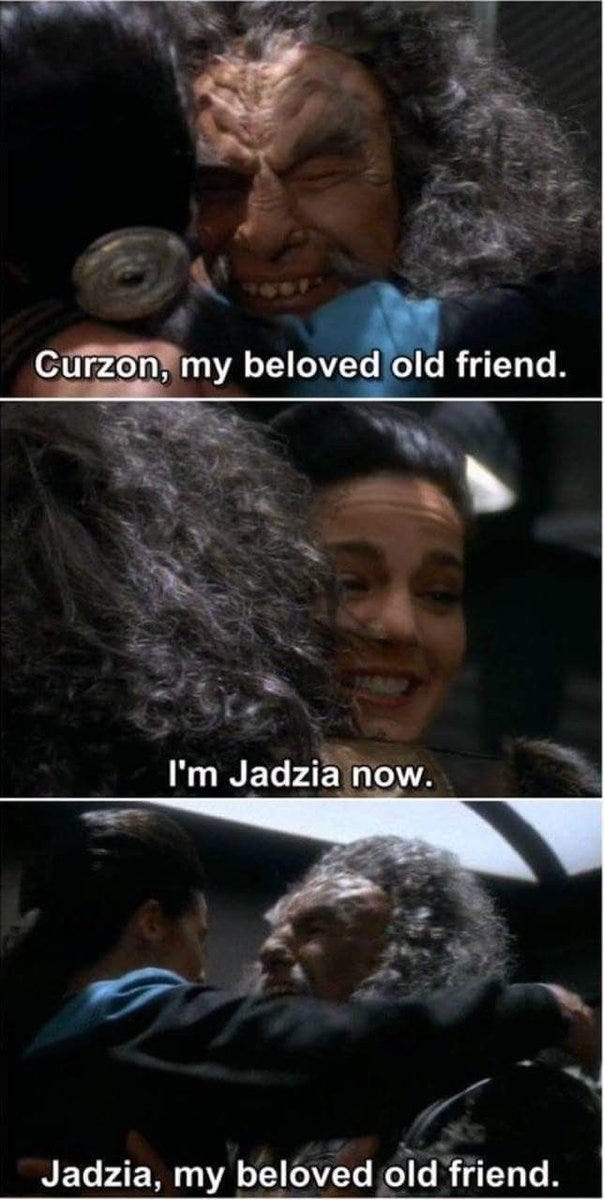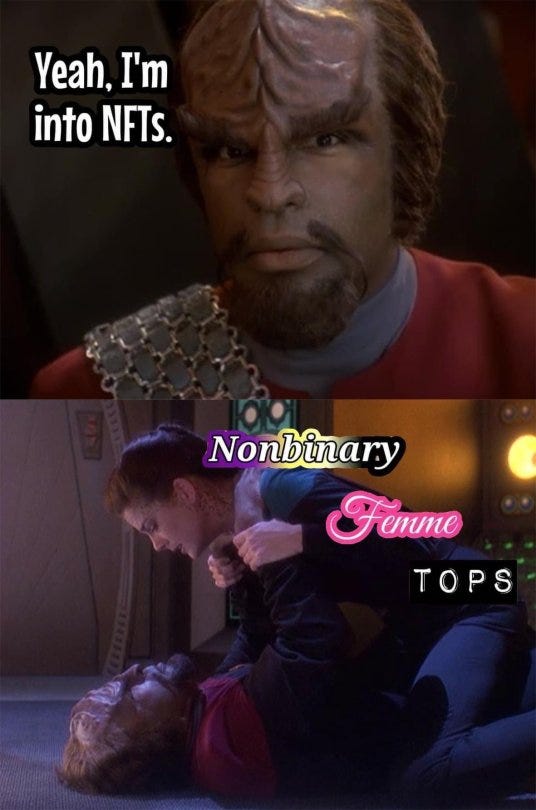Star Trek: Deep Space Nine is one of many Star Trek1 spin-offs. It was unprecedented in many ways, akin to its sibling Star Trek series. However, one character in particular stood out to young me: Jadzia Dax.
Lieutenant Commander Jadzia Dax is of the Trill people, a humanoid species in the Alpha Quadrant. A significant aspect of their culture is the binding of a symbiote and a Trill person, wherein once combined, it is irreversible. However, the newly combined person can now access the memories and skills of all the hosts who once joined with said symbiote.
The screencaps below are from the episode, “Blood Oath,” where the Klingon, Kor, discovers that the Lieutenant in front of him is now the host of the Dax symbiote, which once resided in his old friend, Curzon.
He greets Dax with her former name, and when he is corrected, he promptly changes his response but all while retaining his initial joy.
DS9 aired from January 3, 1993 to June 2, 1999, so it was only until I intentionally rewatched the series (when it was still on Netflix; it is now on Paramount Plus) that I fully understood the beauty in this exchange.
I was always queer, but it wasn’t until high school that I really started to have that conversation with myself.2 And even after more time passed, it wasn’t even until I was in my mid-twenties that I started to question my gender. I had a heart-to-heart with my partner explaining my fear about being non-binary and genderfluid. I am proud to say I am secure enough not to be affected by outside voices regarding my gender. After a quick conversation with my siblings and Nay, they understood.3
But my partner is my person. And I explained that even if folks say they understand my gender, an overwhelming amount of the time I’m still referred to as default “she/her”. And I know that it’s especially easy to default to she/her for me because I’m a soft-spoken, mid-sized Asian fem person, a presentation outside of society’s preconceived definition for non-binary/gender non-conforming, which is a skinny white person in androgynous clothing.4 Plenty of nonbinary folks have voiced this concern and frustration, where they encounter folks who so unwilling to see outside of their perceived notion of gender. Because why does femininity equate to womanhood? Gender nonconforming, genderfluid, and nonbinary folks do not owe society androgyny to be known as their true selves.
There are those who ask, “why not correct them every time?” But it can be so exhausting to include what feels to be another paragraph in an introduction along the lines of, “my pronouns are they/them especially if we’re not close, but I’m a-okay with she/her. But, I’ll definitely notice if you only use she/her with me. And even if we are close, I prefer they/them; but again, I’m okay with she/her.”
I do not and will never shirk my womanhood. I think that’s why now I am more comfortable in the identifier “genderfluid.” My childhood was informed by being assigned female at birth. My adolescence and young adulthood was spent navigating (challenging and opposing) sexism women face. I’ve been stalked and catcalled because condescending assholes perceived me as woman. And a huge part of my adolescence and young adulthood was healing the part of me that grew resentful of being “girly” and wanting “girly” things because I didn’t want folks to think that was the entirety of me. And while this lives in me, the “I am not a woman; I want to be seen as a person outside of gender; I want to remove my breasts and deepen my voice” lives in me too.
The explanation above may be confusing and arbitrary to someone else, but it makes sense to me. Once I knew this was my truth, I felt such a weight lift off me. This was who I am. This was me I was trying so hard to find.
So, as I cried to my partner, I explained: of all people, I didn’t want him to see me as “woman lite". I wanted him to know me, see and understand that everything said above is me, and I want him to still choose to love me.
My partner is a Leo Venus, so he is abundant with his “I love you”s and displays of affection toward me. But “I love you” isn’t always “I love you.” It can be, “did you eat?” or “let me carry that for you,” and “I’ll drive.”
That night, it was, “I’ll always try for you.”
When I see Jadzia, and I see myself. We both harbor the lessons from those before us. We inhabit multitudes. And part of the beauty of gender is the freedom in it.
My writing mirrors my fluidity. In me, there are essays, screenplays, comics, and poems. But there are also: poems-as-comic, poem-as-screenplay, micro-essay-as-comic. Discovering multimedia poetry invites an excitement in me. It reminds me of my love for this craft. Playing with multimedia poetry is my act of living.
The folks who respect and cherish you for you will stay after each and every reveal of you.
Which is all to say, love yourself. Be yourself.
The Star Trek series was created by Gene Roddenberry. It explores ethical and philosophical questions, as well as challenges norms in society during the time in which they were aired
In a previous essay, I talk about this more in-depth
Surprisingly enough, my dad has always treated us “outside of gender”? In that, he never forced gender norms on my sister and I (despite boxing himself inside the toxic masculinity prison, but that’s an essay for another time)
The issues with white people is for another essay





